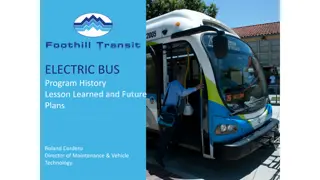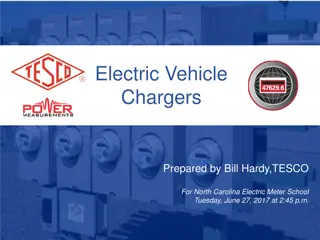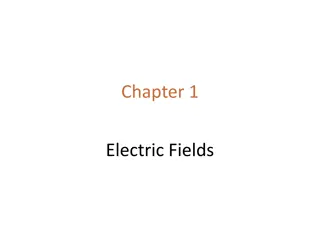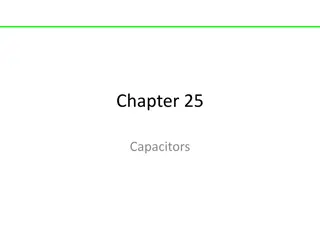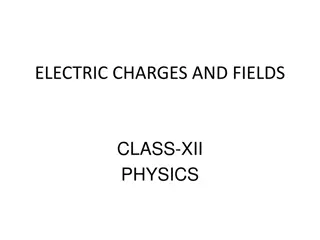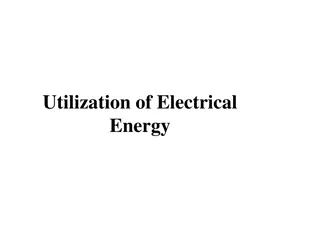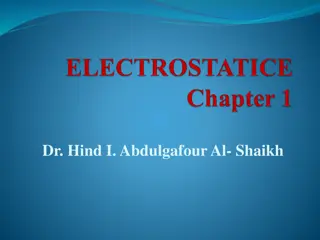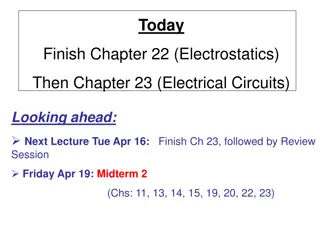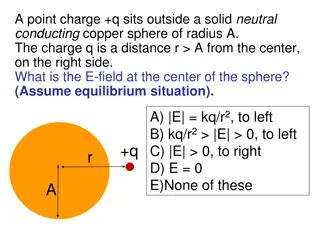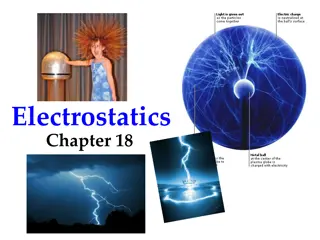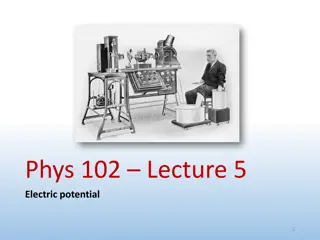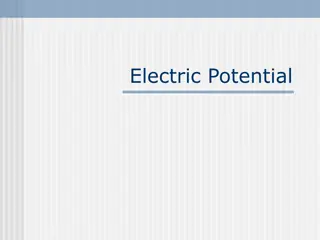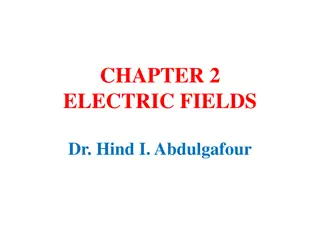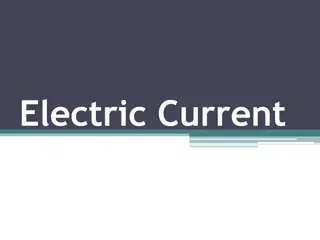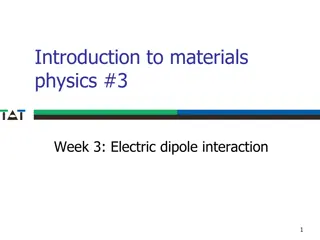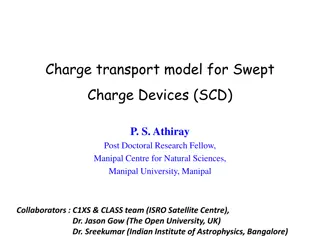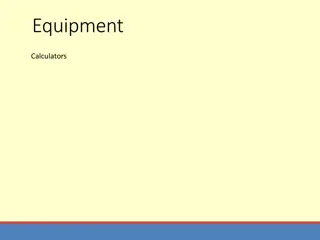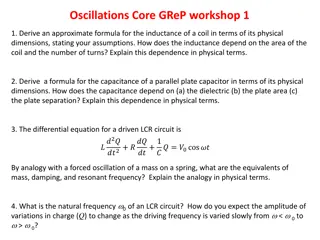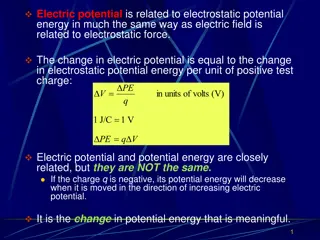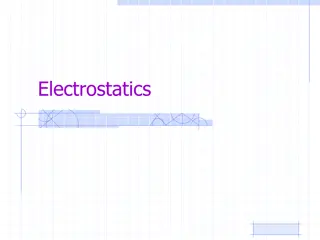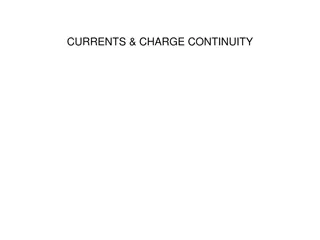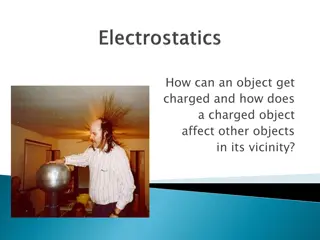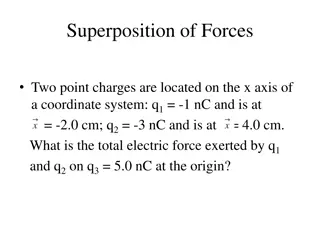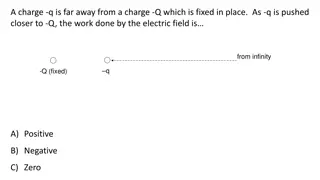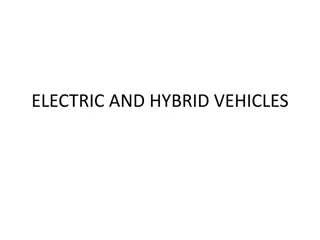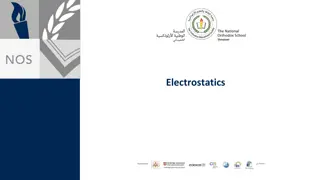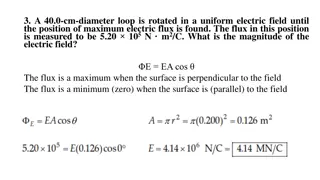Comparative Analysis of Positive Charge's Charging Stations Evolution
This PowerPoint template example created by Romy Bailey for Positive Charge showcases a comparative study of high-speed charging stations versus traditional charging stations, along with a comparison of past year versus current year data, and a year-over-year analysis of Positive Charge's growth. It
1 views • 6 slides
Revolutionizing Electric Mobility: Welcome to Electric Green
Experience the future of electric transportation and energy solutions with Electric Green, a pioneering company dedicated to innovation and sustainability. Discover cutting-edge electric vehicles, lithium-ion batteries, and forward-thinking practices that aim to reshape the way we live and move. Joi
1 views • 7 slides
Understanding Electricity and Circuits: A Comprehensive Overview
Explore the fundamentals of electricity, circuits, and energy in Course 5. Learn about electric charge, system power, losses, energy efficiency, and more. Discover the relevance of understanding electricity and promoting an engineering mindset. Delve into static electricity, properties of electric c
2 views • 21 slides
Foothill Transit Electric Bus Program Overview
Foothill Transit's electric bus program, led by Roland Cordero, Director of Maintenance & Vehicle Technology, has made significant strides since its inception. With a focus on innovation and sustainability, the program has deployed a fleet of fast-charge and extended-range electric buses across vari
3 views • 17 slides
Electric Vehicle Chargers.
Explore the world of electric vehicle chargers, EVSE market trends, and the increasing popularity of electric vehicles. Learn about the growth in charging infrastructure, market statistics, major auto manufacturers' plans for introducing electric vehicles, and strategies to address range anxiety and
1 views • 56 slides
Electric powertrain
The Electric Powertrain Market investigates the global shift towards electric propulsion systems in vehicles. It analyzes trends in electric motors, batteries, and power electronics driving the transition from internal combustion engines to electric powertrains.
0 views • 7 slides
Understanding Electric Fields: Chapter 1 Overview
Delve into the fundamental concepts of electric fields in Chapter 1 as we explore properties of electric charges, charging objects by induction, Coulomb's Law, the electric field, electric field lines, and the motion of charged particles in a uniform electric field. Discover how electric forces shap
1 views • 10 slides
Understanding Capacitors in Physics
Capacitors are electronic components that can store electric charge and energy. This content covers various concepts related to capacitors, such as capacitance, charge storage capacity, electric fields between plates, and capacitance calculations for different geometries. Problems and examples are p
1 views • 46 slides
Understanding Electric Charges and Fields in Physics
Electrostatics is the study of forces, fields, and potentials arising from static charges, including positive and negative charges which interact based on the principles of like charges repelling and unlike charges attracting. By convention, electrons are considered negative, while protons are posit
0 views • 12 slides
Understanding Electric Field Lines and Charges
Electric field lines provide a visual representation of the electric field around charges. They show the direction of the electric field and help understand the intensity of the field at different points. Field lines never cross each other and the tangent at any point on a line gives the field direc
0 views • 40 slides
Utilization of Electrical Energy in Industrial Applications
Electrical energy is widely utilized in various industrial applications, including driving loads with electric motors, electric heating, and welding operations in manufacturing processes. Electric drives offer advantages like low maintenance cost, high efficiency, and easy speed control. Factors to
0 views • 53 slides
Understanding Electric Charges and Conductors in Physics
Explore the fundamentals of electrostatics, electric charges, conductors, and insulators in physics. Learn about the Law of Electric Charges, types of charge, conductors vs. insulators, and methods of charging objects through friction, conduction, and induction. Dive into the world of atoms, electro
1 views • 14 slides
Understanding Electric Current Concepts through Practice Problems
Explore electric current concepts through a series of problems involving charge, current, and electron flow in circuits. Practice calculating current, charge flow, and electron quantities in different scenarios to deepen your understanding of electrical principles.
3 views • 61 slides
Understanding Electric Current in Circuits
Electric current is the flow of electric charge between regions of different electric potential. This flow of charged particles, such as electrons, is essential for circuits to function effectively. Voltage sources, such as batteries or generators, maintain a potential difference necessary for susta
0 views • 31 slides
Understanding Electric Circuits: Current, Voltage, and Resistance
Electric circuits involve the flow of electric current through conductors with varying levels of resistance. Current (I) is the amount of charge passing through a point in a wire per unit of time, measured in amperes. Voltage (V) is the potential difference required to make electrons flow in a condu
0 views • 25 slides
Advancing Electric Commercial Vehicles: SEA Electric's Innovation Journey
Explore the pioneering work of SEA Electric, a Victorian automotive technology company leading the charge in developing efficient 100% electric vehicle drivetrains for commercial use. With their SEA-DriveTM technology and exclusive models, SEA Electric is spearheading the transition towards sustaina
0 views • 10 slides
Understanding Electric Fields and Charges in Different Scenarios
Explore various scenarios involving electric fields and charges such as the E-field at the center of a conducting sphere, the effect of total charge on E-field, E-field above a charged conductor, charge distribution on the surface of a copper sphere with a hollow, field inside a charged non-conducti
0 views • 9 slides
Understanding Electric Displacement in Dielectrics and Charge Distributions
Electric displacement in dielectrics involves the interaction of external fields, induced fields, and bound charges, leading to the total electric field. The concept is further explored in contexts like linear dielectrics, dielectric spheres, and charge distributions in solid dielectric rods. Key eq
0 views • 27 slides
Exploring Electric Potential and Equipotentials in Physics
Delve into the concepts of electric potential, equipotentials, and potential energies in physics. Learn about field lines, partial derivatives, potential energy changes for various charge configurations, and the significance of equipotentials. Understand how to calculate total potential energy for m
0 views • 27 slides
Understanding Electrostatics: Atomic-Level Insights into Electric Charges
Delve into the world of electrostatics to explore the study of electric charges and their interactions at the atomic level. Discover how positive and negative charges behave, how electrons and protons play a crucial role, and the conservation of charge in fundamental particles. Unravel the mysteries
0 views • 25 slides
Understanding Electric Potential in Physics
Today's lecture covers the concept of electric potential, superposition principle, representation with equipotential lines, relation with electric field, and applications like Electrocardiogram (ECG). It explains the definition of electric potential, its scalar nature, and calculation examples invol
0 views • 22 slides
Understanding Electric Potential and Energy in Physics
Electric potential and energy play essential roles in physics, influencing the behavior and interactions of charged particles in electric fields. This content explores concepts like electric potential, gravitational potential energy, electric potential energy of point charges, and the work involved
0 views • 28 slides
Understanding Electric Circuits: Basics and Examples
An exploration of electric circuits, including their components, symbols, and the flow of current. Learn about examples of electric circuits used in devices like televisions and loudspeakers. Test your knowledge with questions on circuit symbols, the definition of an electric circuit, and examples o
0 views • 11 slides
Understanding Electric Fields: Fundamentals and Concepts
Electric fields are created by surrounding charges and are represented by vectors indicating the force experienced by a test charge. Electric field lines help visualize the direction and strength of the field, with denser lines indicating stronger fields. The electric field due to a point charge can
0 views • 13 slides
Physics Chapter 23 Problems Solutions
Explore solutions to various physics problems from Chapter 23, including calculating electric forces between protons, resultant electric force on charges, mass of charged objects in electric fields, electric field and forces between point charges, and calculating particle speeds in electric fields.
0 views • 17 slides
Understanding Electric Current and Electric Potential Difference
Electric current is the flow of electrons moving from one point to another, measured in amperes. The direction of current follows convention, even though electrons actually move oppositely. Current is calculated using the total charge passing a point in a given time. Electric Potential Difference (E
0 views • 22 slides
Understanding Electric Dipole Interaction in Materials Physics
Dive into the world of electric dipole interaction in materials physics, exploring topics such as electromagnetic wave properties, force acting on electric dipoles, potential energy calculations, and the representation of waves through phasors. Learn about the differences between electromagnetic wav
0 views • 22 slides
Charge Transport Model for Swept Charge Devices (SCD) in Astrophysics Research
Exploring the charge transport model for Swept Charge Devices (SCD) in collaboration with various institutions like ISRO Satellite Centre and e2V technologies Ltd. The research aims to enhance spectral response, reduce uncertainties, and improve global lunar elemental mapping using advanced X-ray sp
0 views • 30 slides
Understanding Current and Charge in Electric Circuits
Learn how to calculate current and charge in electric circuits, identify circuit components, and perform calculations using the equation Q = It. Explore the concepts of current, charge flow, and key circuit symbols through practical examples and explanations. Enhance your understanding of electric c
0 views • 20 slides
Understanding Inductance and Capacitance in Electric Circuits
Explore the derivation of inductance and capacitance formulas in terms of physical dimensions and learn about the dependencies on coil area, number of turns, dielectric, plate area, and plate separation. Understand how inductance relates to magnetic flux and coils while capacitance is linked to char
0 views • 16 slides
Understanding Electric Potential and Its Relationship to Electrostatic Energy
Electric potential is intricately linked to electrostatic potential energy, much like how electric field correlates to electrostatic force. The change in electric potential equals the change in electrostatic potential energy per unit positive test charge, expressed in volts. By exploring scenarios s
0 views • 24 slides
Understanding Electrostatics: Charges, Objects, and Conservation Law
Electrostatics is the study of stationary electrical charges, where objects can be neutral, positively or negatively charged based on the balance of electrons. The charge of electrons and protons, elementary charge, examples of charge calculation, and the law of conservation of charge are key concep
0 views • 25 slides
Understanding Electric Currents and Charge Continuity
Explore the concepts of electric currents, charge continuity, volume current density, surface current density, and more through a series of questions and visuals. From understanding the flow of ions in a liquid to calculating current densities in wires, this content delves into essential principles
0 views • 10 slides
Understanding Electric Charge and Interactions Between Objects
Matter is composed of neutrons, protons, and electrons with different charges. Being charged means having an excess or shortage of charge. Grounding, insulators, conductors, and methods of charging play important roles in how objects get charged. By contacting charged objects with objects that can g
0 views • 33 slides
Electric Charges and Fields in Physics
Explore topics such as superposition of forces, electric fields, particle interactions, potential differences, and cathode-ray tube concepts in physics involving charges, forces, and fields. Understand scenarios like calculating total electric force between charges, finding electric fields at specif
0 views • 10 slides
Understanding Electric Field Work and Potential Energy Changes
Exploring scenarios involving charges moved in electric fields, determining work done, changes in potential energy, and charge movements. Clarification on external agent work, system energy changes, and charge direction predictions provided.
0 views • 49 slides
Understanding Electric and Hybrid Vehicles: Hybridization and Interdisciplinary Aspects
Electric and hybrid vehicles (HEVs) feature different hybridization ratios based on the power rating of their electric motors. Concepts like full hybrid, mild hybrid, and micro hybrid define the extent of electric motor usage for driving. HEVs involve a mix of electric machines, power electronics, b
0 views • 50 slides
Understanding Static Electricity and Electrostatics
Static electricity is a result of electric charge buildup on insulating materials due to friction, causing electrons to transfer and create a charge difference. This can lead to phenomena like a balloon sticking to a wall. The origin of static charge lies in the electrons and protons within atoms, w
0 views • 9 slides
Electric Field and Flux Calculations in Different Geometries
Explore various scenarios involving electric fields and flux calculations, such as finding the magnitude of electric fields in different situations, determining electric flux through surfaces, assessing net electric flux through charges in a submarine, and analyzing flux through faces of geometric s
0 views • 13 slides
Enhancing Consumer Protection in Connecticut's Electric Supplier Enforcement
This content discusses various initiatives and regulations in Connecticut aimed at promoting transparency and protecting consumers in the electric supplier market. Topics covered include electric bill clarity, a ban on variable rates, data showing differences in costs between supplier and standard s
0 views • 17 slides



